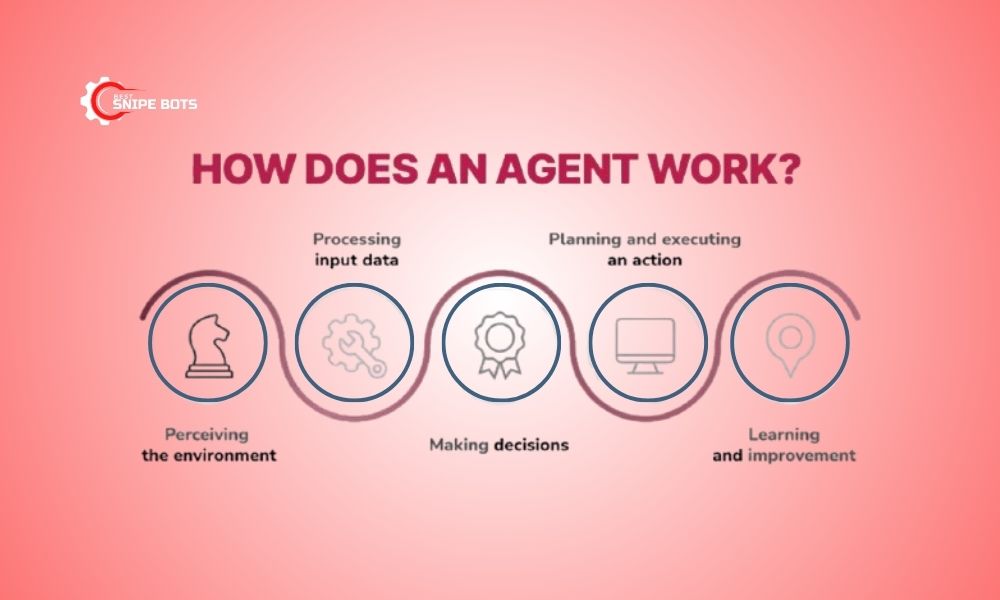How does an AI agent work is a key question as artificial intelligence becomes more integrated into our lives. Essentially, an AI agent is an autonomous entity that observes its environment through sensors and acts upon that environment through actuators to achieve specific goals. This operation is not a single action but a continuous, intelligent cycle that defines its behavior.
How does an AI agent work?
In the world of technology, an “agent” is not necessarily a humanoid robot from science fiction. It can be a software program filtering your spam, a virtual assistant on your phone, or a complex self-driving car. Regardless of its form, the fundamental answer to how does an AI agent work lies in a repetitive, cyclical process. This cycle allows the agent to interact with, reason about, and learn from its surroundings.
So, specifically, how does an AI agent work through each stage? Let’s analyze the five-step cycle illustrated in the image.
The 5 core steps of an AI agent’s cycle

This is the operational foundation for every intelligent agent, from the simplest to the most sophisticated.
Step 1: Perceiving the environment
This is the initial step where the AI agent gathers raw data from its surroundings using “sensors.” This process is analogous to how humans use their five senses to understand the world.
- Real-world example: A self-driving car uses cameras, LiDAR, and radar to “see” other vehicles, pedestrians, and road signs. A virtual assistant uses a microphone to “hear” your commands.
- Icon in the image: The chess knight icon aptly represents this step—observing the “chessboard” (the environment) to understand the current state before making any move.
The data collected here is completely raw and unprocessed.
Step 2: Processing input data
The raw data from sensors is often noisy and complex. The agent must process, filter, and interpret this data to turn it into structured, useful information. Transforming raw data into knowledge is a critical part of how does an AI agent work.
- Real-world example: A self-driving car’s system processes camera data to recognize “that is a truck” instead of just seeing a “block of pixels.” A virtual assistant converts sound waves into text to understand a request.
- Icon in the image: The gear and wrench icon symbolizes this “refining” process, making the data valuable for decision-making.
Step 3: Making decisions
This is the “brain” of the AI agent. Based on its programmed goals and the information it has just processed, the agent selects the best possible action from a range of options. This step is the heart of the process, directly answering the question: how does an AI agent work?
- Real-world example: A chess-playing agent will analyze millions of possible moves to select the one with the highest probability of winning. An email filtering system will decide if a new message is “important” or “spam.”
- Icon in the image: The ribbon award icon represents selecting the “winning” or best decision to achieve its objective.
Step 4: Planning and executing an action
Once a decision is made, the agent executes it through its “actuators” to affect the environment.
- Real-world example: A self-driving car’s decision to “slow down” is executed by sending a signal to the braking system. A virtual assistant’s decision to “answer a question” is executed by generating sound through a speaker.
- Icon in the image: The computer monitor icon symbolizes “outputting” the action or result into the external world, creating a change in the environment.
Step 5: Learning and improvement
This is the crucial element that makes an agent truly “intelligent.” After taking an action, the agent observes the outcome and receives feedback from the environment. This feedback is used to update its knowledge and improve future decisions. Without this final step, the explanation for how does an AI agent work would be incomplete.
- Real-world example: If a game-playing agent makes a move and loses, it will “learn” that it was a bad strategy and be less likely to repeat it (reinforcement learning).
- Icon in the image: The map pin icon is fitting, showing the agent “recalibrating its map” and finding a new, better path based on accumulated experience.
In summary, the entire mechanism of an AI agent revolves around this five-step loop of perceiving, processing, deciding, acting, and learning. Understanding how does an AI agent work reveals a powerful tool built on logical principles. To explore more insightful tech topics and stay updated, be sure to follow Best Snipe Bots.